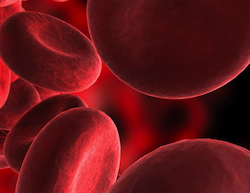Activity Monitoring Discriminates Between BP Kids and ADHD Kids
At the 57th Annual Meeting of the American Academy of Child and Adolescent Psychiatry (AACAP) in October 2010, Gianni Faedda of the Lucio Bini Mood Disorders Center reported that monitoring of activity, sleep, and circadian-rhythm disturbances can be used to distinguish children with a diagnosis of bipolar illness (who showed more hyperactivity and less sleep), from children with ADHD and control children without illness.
Lower Blood Iron Levels Linked to More Severe ADHD
 At the 57th Annual Meeting of the American Academy of Child and Adolescent Psychiatry (AACAP) in October 2010, Chadi Calarge of the University of Iowa’s Carver College of Medicine reported that among children with attention-deficit hyperactivity disorder (ADHD), blood iron levels were inversely correlated with the severity of ADHD symptoms. That is, those with lower iron levels in their blood had greater severity of ADHD symptomatology and, in addition, required higher doses of stimulants to achieve effective results.
At the 57th Annual Meeting of the American Academy of Child and Adolescent Psychiatry (AACAP) in October 2010, Chadi Calarge of the University of Iowa’s Carver College of Medicine reported that among children with attention-deficit hyperactivity disorder (ADHD), blood iron levels were inversely correlated with the severity of ADHD symptoms. That is, those with lower iron levels in their blood had greater severity of ADHD symptomatology and, in addition, required higher doses of stimulants to achieve effective results.
Editor’s note: It would appear clinically useful to check blood iron levels in patients with ADHD symptomatology, particularly when symptoms are severe or when the illness requires very high doses of stimulants to achieve therapeutic effects.
Phosphatidylserine Omega-3 Fatty Acids in ADHD
Iris Manor reported at the 57th Annual Meeting of the American Academy of Child and Adolescent Psychiatry (AACAP) in October 2010 that phosphatidylserine (a phospholipid component) containing omega-3 fatty acids had significant positive effects in children with ADHD. These findings were notable because Manor and other investigators had previously found that omega-3 fatty acids themselves were not effective in ADHD, raising the possibility that the phosphatidylserine component offers unique therapeutic advantages. This compound is currently available in Israel and may become available in the US in the next year.
Memantine for Adult ADHD
At the 57th Annual Meeting of the American Academy of Child and Adolescent Psychiatry (AACAP) in October 2010, Craig Surman of Massachusetts General Hospital reported results from an open study suggesting that the anti-Alzheimer’s drug memantine (Namenda) was effective in the treatment of ADHD in adults.
Editor’s Note: Gianni Faedda also indicated to this writer that he had successfully used memantine, an antagonist of the glutamate NMDA receptor, for children with ADHD. He observed that memantine was also helpful in several of his treatment-resistant bipolar patients. Based on these anecdotal observations, this compound deserves further systematic exploration. It is also noteworthy that Amit Anand and colleagues found that memantine increased antidepressant response to lamotrigine in bipolar depression compared to placebo.
Children with ADHD and Oppositional Symptoms Respond to Guanfacine
Researcher Daniel Connor reported at the 65th Annual Scientific Convention of the Society of Biological Psychiatry that children aged 6-12 with oppositional symptomatology and attention-deficit/hyperactivity disorder (ADHD) improved on guanfacine XR.
Doses ranged from 1 to 4 mg/day, with a mean dose of 2.9 mg/day. There was a substantial decrease in oppositionality (a finding with a moderate effect size of 0.59) and a marked decrease in ADHD symptomatology (a finding with a large effect size of 0.92). Side effects included drowsiness (in 51% of subjects), headache (22%), sedation (13%), abdominal pain (12%) and fatigue (11%). Guanfacine is not a psychomotor stimulant, like most of the treatments for ADHD are, but an agonist (activator) of noradrenergic ?2 receptors in the brain.
Revisions of the DSM-V Related to Bipolar Disorder in Children
 The Pediatric Bipolar conference in March ended with a discussion led by Ellen Leibenluft and Danny Pine of the NIMH about possible changes in the diagnostic criteria for childhood onset bipolar disorder being considered for the fifth version of the Diagnostic and Statistical Manual of Mental Disorders (DSM-V), which will be finalized in the next few years. There has been an increase in the diagnosis of bipolar disorder in children in the past decade, and many have attributed this to over-diagnosis. Controversy about the precise symptoms and thresholds for diagnosis has been prominent in the literature and in the popular press.
The Pediatric Bipolar conference in March ended with a discussion led by Ellen Leibenluft and Danny Pine of the NIMH about possible changes in the diagnostic criteria for childhood onset bipolar disorder being considered for the fifth version of the Diagnostic and Statistical Manual of Mental Disorders (DSM-V), which will be finalized in the next few years. There has been an increase in the diagnosis of bipolar disorder in children in the past decade, and many have attributed this to over-diagnosis. Controversy about the precise symptoms and thresholds for diagnosis has been prominent in the literature and in the popular press.
The major change proposed was that the syndrome of severe mood dysregulation (SMD) described by Leibenluft et al. in 2003, may be called Temper Dysregulation Disorder (TDD), and would not be considered part of the bipolar spectrum. This is in part because SMD is not associated with an increased incidence of a positive family history of bipolar illness. Part of the motivation for separating TDD from bipolar illness is to cut down on what some consider the over-diagnosis of bipolar disorder in children.



